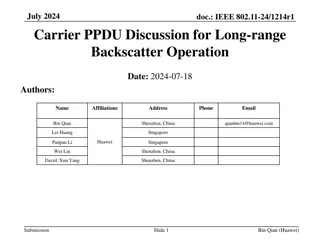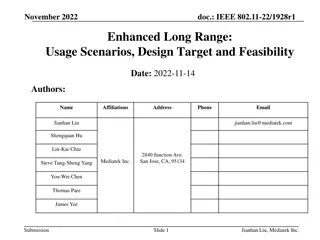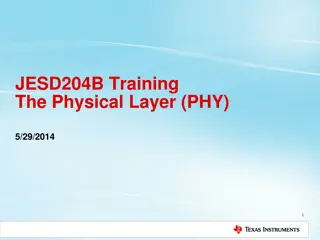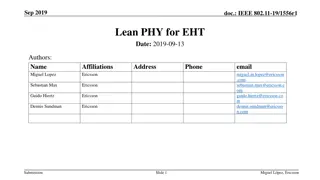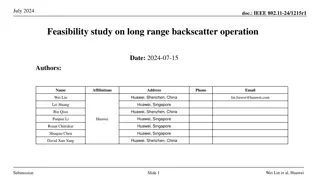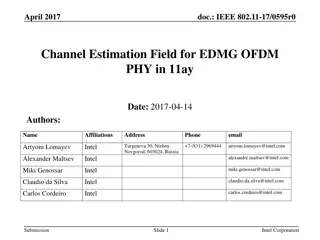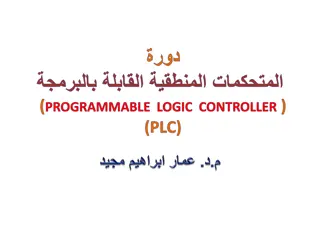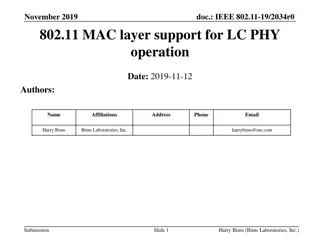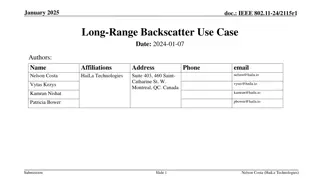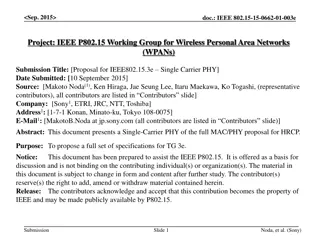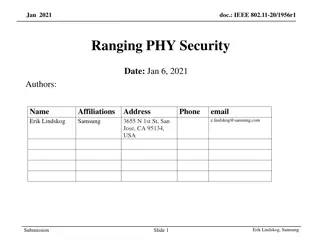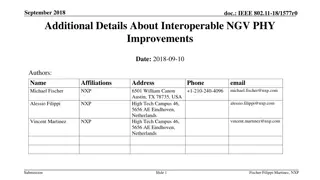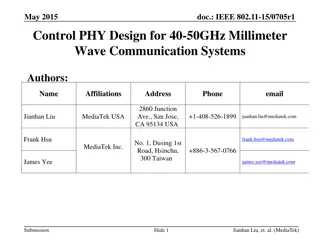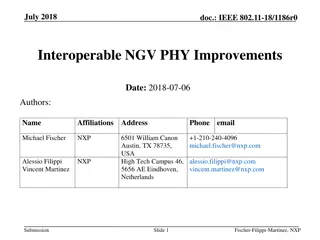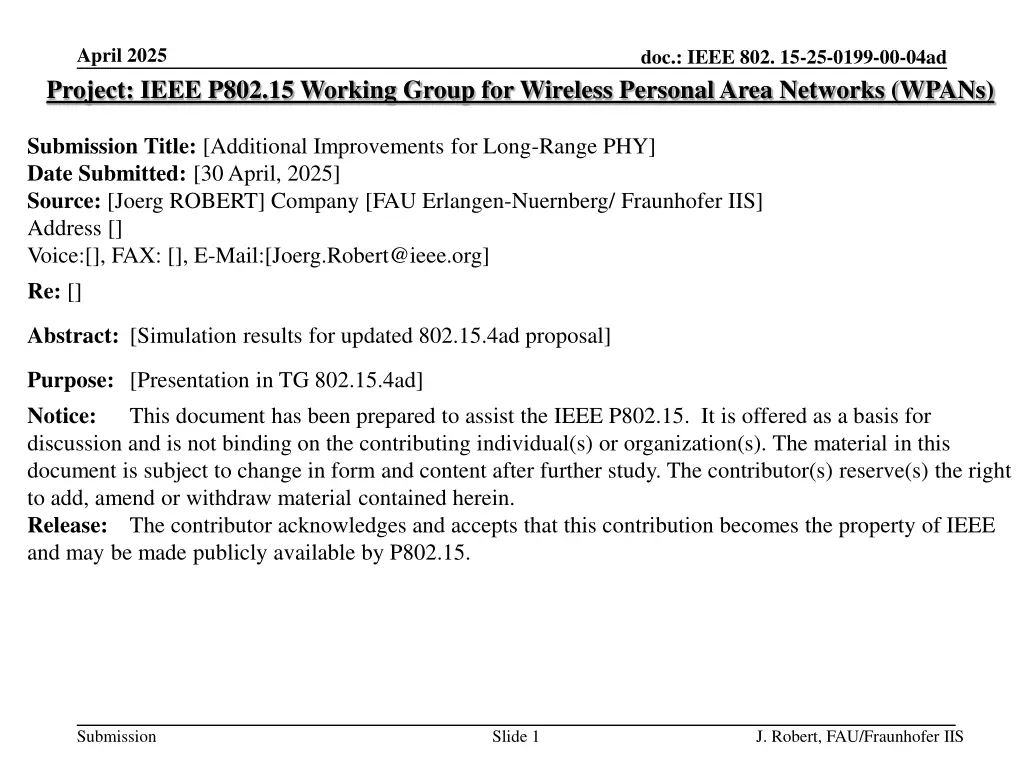
Improved Long-Range PHY Proposal for IEEE 802.15 Working Group
"Explore the additional improvements for long-range PHY in the IEEE 802.15.4ad proposal by Joerg Robert from FAU Erlangen-Nuernberg/Fraunhofer IIS. Details include simulation results, background, assumptions, and comparisons with the current TI proposal."
Download Presentation

Please find below an Image/Link to download the presentation.
The content on the website is provided AS IS for your information and personal use only. It may not be sold, licensed, or shared on other websites without obtaining consent from the author. If you encounter any issues during the download, it is possible that the publisher has removed the file from their server.
You are allowed to download the files provided on this website for personal or commercial use, subject to the condition that they are used lawfully. All files are the property of their respective owners.
The content on the website is provided AS IS for your information and personal use only. It may not be sold, licensed, or shared on other websites without obtaining consent from the author.
E N D
Presentation Transcript
April 2025 Project: IEEE P802.15 Working Group for Wireless Personal Area Networks (WPANs) doc.: IEEE 802. 15-25-0199-00-04ad Submission Title: [Additional Improvements for Long-Range PHY] Date Submitted: [30 April, 2025] Source: [Joerg ROBERT] Company [FAU Erlangen-Nuernberg/ Fraunhofer IIS] Address [] Voice:[], FAX: [], E-Mail:[Joerg.Robert@ieee.org] Re: [] Abstract: [Simulation results for updated 802.15.4ad proposal] Purpose: [Presentation in TG 802.15.4ad] Notice: This document has been prepared to assist the IEEE P802.15. It is offered as a basis for discussion and is not binding on the contributing individual(s) or organization(s). The material in this document is subject to change in form and content after further study. The contributor(s) reserve(s) the right to add, amend or withdraw material contained herein. Release: The contributor acknowledges and accepts that this contribution becomes the property of IEEE and may be made publicly available by P802.15. Submission Slide 1 J. Robert, FAU/Fraunhofer IIS
April 2025 doc.: IEEE 802. 15-25-0199-00-04ad Additional Improvements for the Long-Range PHY Joerg Robert (FAU/Fraunhofer IIS) Submission Slide 2 J. Robert, FAU/Fraunhofer IIS
April 2025 doc.: IEEE 802. 15-25-0199-00-04ad Background Our proposal for Narrowband [3] bases on the TI proposal [4] with specific extension for improved performance The differential modulation reduces the performance However, the performance can be improved in a backwards compatible way Optimized receivers could utilize this for significantly improved performance Submission Slide 3 J. Robert, FAU/Fraunhofer IIS
April 2025 doc.: IEEE 802. 15-25-0199-00-04ad Simulation Assumptions Simulation of TDL-B/D and interference according to Technical Guidance Document [5] Realistic channel and noise estimation Perfect timing synchronization assumed preambles are currently not part of the signal 1000 packets or 20 erroneous packets Packet length of 20 payload bytes Noise figure F=0dB OFDM parameters are 120 s symbol duration with 108 active carriers, DSSS = 2 Submission Slide 4 J. Robert, FAU/Fraunhofer IIS
April 2025 doc.: IEEE 802. 15-25-0199-00-04ad Current TI Proposal TI Proposal [4] The proposed code is a Walsh Code with length 2 (AlmostQ) ideal decoding algorithm without channel knowledge: The output vector contains the LLR (soft-bits) used for the Viterbi decoder Submission 5 J. Robert, FAU/Fraunhofer IIS
April 2025 doc.: IEEE 802. 15-25-0199-00-04ad Sophisticated Decoding Future receivers could exploit channel knowledge for improved decoding Perfect coherent decoder for current proposal: The first symbol of the symbol is not required for the decoding It does not provide any information and leads to a loss of at least 3 dB as 50% of the data is not used Submission 6 J. Robert, FAU/Fraunhofer IIS
April 2025 doc.: IEEE 802. 15-25-0199-00-04ad Proposal Instead of toggling the phase of the first reference symbol it can also be used to transmit additional redundancy No change to current receiver implementation Significant additional gain for future receivers Information theoretical gain due to lower rate, i.e. All transmitted symbols carry payload information Additional robustness for erasure channels (interference, fading) Submission 7 J. Robert, FAU/Fraunhofer IIS
April 2025 doc.: IEEE 802. 15-25-0199-00-04ad How does it Work? Normal output as already used in the current proposal and other IEEE 802.15.4 Std These output replace the bit toggling on slide 2. Their decoding in the receiver is optional! Polynomial o133, o171, o145, o133 Submission 8 J. Robert, FAU/Fraunhofer IIS
April 2025 doc.: IEEE 802. 15-25-0199-00-04ad Transmitter Side Implementation Normal Modulation as in current proposal Additional bits of the convolutional code flip all output bits no change to relative phase Use of the currently unused phase of the signal Submission 9 J. Robert, FAU/Fraunhofer IIS
April 2025 doc.: IEEE 802. 15-25-0199-00-04ad Gain of Lower Code-Rates Lower codes provide additional gain and should be preferred compared to repetition Repetition is linear and does not provide Eb/N0 gain The 3dB due to the use of all bits come in addition Details are given in [6] Can be combined with additional iterative decoding to squeeze the last information out of the channel >6dB gain compared to current approach without changing the RX Submission 10 J. Robert, FAU/Fraunhofer IIS
April 2025 doc.: IEEE 802. 15-25-0199-00-04ad Decoding Performance in AWGN Optimized Proposal Normal Decoder Decoder for proposed decoding is not optimized yet Significantly higher gains in fading channels Submission 11 J. Robert, FAU/Fraunhofer IIS
April 2025 doc.: IEEE 802. 15-25-0199-00-04ad Comparison TI & Bound of Proposed Scheme TI Proposal [4] Bound for Optimized Approach Bound is for AWGN channel Bound can be reached by iterative decoder There is no way to further optimize the system Submission 12 J. Robert, FAU/Fraunhofer IIS
April 2025 doc.: IEEE 802. 15-25-0199-00-04ad Additional Remarks The presented approach is only useful when the system hops after the transmission of a single symbol FCC 15.247 compliant mode, i.e. the TI proposal For countries where such fast frequency hopping is not required, multiple symbols can also be transmitted as proposed in [7, Slide 8/9] The proposal in [7] will most likely reach similar performance figures. However, we could minimize the number of modes, e.g. use only 8 payload symbols per hop Submission Slide 13 J. Robert, FAU/Fraunhofer IIS
April 2025 doc.: IEEE 802. 15-25-0199-00-04ad Conclusions and Next Steps This presentation shows an extension to the TI proposal The proposal does not affect the existing TI proposal on the receiver side Future devices will be able to exploit the additional data to achieve a performance close to the theoretical limits The additional redundancy helps to improve the performance in case of interference For Warsaw we will provide additional simulation results for the multi-path channels We will also provide results on the 8 symbols proposal Submission Slide 14 J. Robert, FAU/Fraunhofer IIS
April 2025 doc.: IEEE 802. 15-25-0199-00-04ad Literature [1] J. Robert and A. Heuberger, "LPWAN downlink using broadcast transmitters," 2017 IEEE International Symposium on Broadband Multimedia Systems and Broadcasting (BMSB), Cagliari, Italy, 2017 [2] J. Robert, J. Zoellner and M. Slimani, "Adaptive Windowing for OFDM with Dense Subcarrier Spacing in Mobile Channels," OFDM 2012; 17th International OFDM Workshop 2012 (InOWo'12), Essen, Germany, 2012 [3] FAU/Fraunhofer IIS Proposal, DCN 15-25/0049r00 [4] TI Proposal, DCN 15-24/0651r01 [5] Technical Guidance Document, DCN 15-24/0061r16 [6] S. Dolinar, et al. "Code performance as a function of block size." TMO progress report 42.133 (1998). https://tda.jpl.nasa.gov/progress_report/42-133/133K.pdf [7] Kyoto University Proposal, DCN 15-25/158r02 Submission Slide 15 J. Robert, FAU/Fraunhofer IIS


